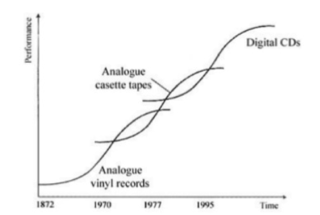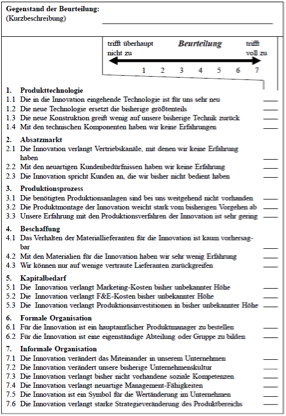What is the degree of innovation?
The degree of innovation is a central key variable for the use of management activities and instruments in the course of an innovation process. You can find out how the degree of innovation can be determined and the benefits it has for the innovation success in this blog contribution.

The degree of innovation refers to the level or magnitude of novelty and change introduced by an innovation. It is categorized as either radical (disruptive, transformative) or incremental (evolutionary, gradual) based on the extent of impact, resources required, and level of risk involved.
Innovation as a key factor for successful innovation
Essentially more important than a clear definition from the textbook or the assessment of novelty after the introduction of innovation is the determination of the degree of innovation in the run-up to an innovation project in order to define the goal of innovation management:
On the one hand, sensible, smart targets can only be defined if the company makes a clear distinction between types of innovation and degrees of innovation. On the other hand, a distinction should be made between innovation types and degrees of innovation in the early phase of innovation management, ie in the stage of ideas, in order to be able to pursue ideas appropriately. For example, product innovations belong to classical product management, which are integrated into the ongoing R & D activities. For ideas with a higher degree of innovation or innovative business models, it is often necessary to form their own detached teams and separate the innovation project from the day-to-day business.
Defining the degree of innovation is therefore not an end in itself for a company, but serves for effective innovation management. The degree of innovation is to be seen as a key factor which is of great relevance both in the determination of success factors in the development of innovative products as well as in an adequate innovation strategy in operational practice.
Definition of innovation
The degree of innovation defines how "new" is an innovation. The gradual difference from the previous state is to be measured and evaluated. The assessment of innovations in novelty can be carried out both after the introduction of the novelty and in the run-up to an innovation project. Once a new product, a service or a new process has been introduced, the degree of innovation can be assessed in the future. At the same time, the degree of innovation also characterizes the complexity of an innovation project.
How radical innovations differ from incremental innovations
How new is an innovation is often also a subjective consideration. An innovation can therefore be new
- For a company,
- For a market or industry, or
- For the entire world.
Another frequently used classification for innovation according to novelty is according to the scope of change: Radical innovations are new products, services or processes and embrace a substantial change and innovation. Accordingly, the impact is also greater, for example new markets may arise.
Incremental innovations are the optimization and further development of Existing products, services or processes. The purpose and benefits are the optimization of customer service, cost reduction, repositioning, adaptation to new markets or the adaptation to new conditions such as new laws and standards.
Accordingly, radical innovations are basic innovations and revolutions, incremental innovation improvement, adaptation or subsequent innovations and thus evolution.
Incremental innovation vs. radical innovation
Incremental innovations show a low degree of innovation. These are small changes to existing products, processes, or business models that the company operates in a known or similar market. They do not imply new knowledge or new technology. Known technologies, products, services, business models or processes are being further developed,
- Reduction of costs or functional improvements in existing products, services or processes
- Use existing knowledge
- Increases competitiveness in existing markets or industries
- Low uncertainty
- Further development and improvement of already established products and product processes
- Prerequisite: long-term employment contracts, stable career structures and industrial tariff agreements
Radical innovations, on the other hand, represent something fundamentally new, which cause considerable changes in the product, process or business model. They have a very high degree of innovation.
- New products, services or processes with innovative properties
- Based on new knowledge
- Makes significant change that transforms entire markets or industries or creates new one
- High uncertainty
- Require a sharp break with traditional routines and delivered knowledge
- Prerequisite: deregulated labor markets, fast access to risk capital necessary
An example of radical innovations as a result of major technological changes are mobile music devices: the mobile CD device was a radical innovation compared to its predecessor, the (cassette) walkman, and the MP3 player was just as opposed to the CD device.

Source: Rykroft and Kash (1999, 54)
Whether an innovation is radical or incremental is often very much in the eye of the beholder. Therefore, a clear, objective differentiation is often challenging.
It is important for companies and their innovation management to set criteria for themselves, according to which innovations are divided into incremental and radical innovations. Examples of criteria are return on investment, amount of investment costs, payback period, patentability, etc. Thus, innovative ideas with a high ROI, high investment costs, longer amortization and patentable are radical.
Further models: Innovative level according to Jürgen Hauschildt
The German economist Jürgen Hauschildt defines innovation as a novel combination of purpose and means. On the one hand, the means (solution principle, technology) are an offering of new problem solving through innovative ideas. On the other hand, a new purpose (need, customer use, application) can be followed.
Hauschildt's model is an extension of the above approach. It distinguishes four levels of innovation:
- Incremental innovation: improving an existing purpose using existing methods. The degree of innovation is very low as only minor changes are made to existing products, processes or business models.
- Medium-Innovated Innovation: new means are offered for the fulfillment of existing or new purposes. Medium-innovated innovations are predominantly based on the R & D activities of a company, which often have a higher degree of innovation compared to purpose-driven innovations.
- Purpose-induced innovation: A new purpose emerges, which is fulfilled with unchanged or new means. Triggered innovations are often triggered by the needs or the demand of the customers in the market. The degree of innovation is located here in the middle area.
- Breakthrough innovation: These innovations are characterized in particular by the fact that completely new means or a new technology will meet a hitherto unknown need with great benefit to the customer. Breakthrough innovations show a very high degree of innovation and are also referred to as disruptive innovations. They often have their starting point in a barely recognized niche and initially address only a small number of customers before they become a dominant market factor and displace established companies from the market.
How can the degree of innovation be measured in detail?
In particular, the assessment of the degree of innovation of breakthrough innovations requires as many indications as possible to determine the extent of technological and application-related changes. As the level of innovation increases, the time and resource consumption increases, while the risk of failure grows disproportionately. Costs and cost structures also often break familiar concepts of controlling and require higher financing potential.
A detailed multi-dimensional analysis, which expresses the degree of innovation in a key figure, is therefore an important decision-making base for an innovation project. In practice, scoring models are frequently used, which determine the degree of innovation through different weightings at the individual points of reference. The following is an example of how to determine the degree of innovation using a checklist in the scoring process.

Source: Case studies on innovation management; Jan Hendrik's Profile Fisch, Jan-Michael Roß
Conclusion: Innovation degree = central key variable
The higher the level of innovation, the greater the uncertainty for the innovating company in the areas of technology, market, environment, resources and organization. The determination of the degree of innovation at the beginning of an innovation project ensures that the consequences of the innovation project are systematically investigated. Only the estimation of the expected degree of innovation enables management to determine the appropriate methodology and approach in the innovation process.











